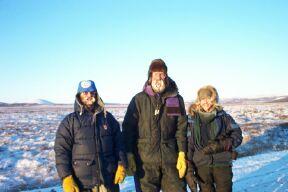
|
|
3 December, 2001
Bundled in six layers of clothes, bunny boots, and layers of hats The
first snow measurements were taken near Council. Albedo measurements were
taken across the tundra. Albedo is the ratio of outgoing solar radiation
from the snow or ground to the incoming solar radiation from the
atmosphere. An albedo measurement of 1 would mean that all of the incoming
solar radiation would be reflected back into the atmosphere. An albedo
measurement of 0 would mean that all of the radiation was being absorbed by
the snow/ground. Because snow is white, it strongly reflects solar
radiation. On the opposite end, something black strongly absorbs solar
radiation. So a deep layer of snow would be very reflective and have a
high albedo. On the other hand, snow also acts like a huge insulating
blanket on the ground. The more snow cover on the ground, the warmer the
ground will stay. The less snow on the ground, the cooler the ground will
become. Shrub height on the tundra plays an essential role in snow cover
and ground temperature. Taller shrubs trap more snow, making a deeper snow
cover. This in turn keeps the ground warmer, leading to even taller
shrubs. The albedo of tundra with tall shrubs is on the lower end of the
0-1 albedo scale. This is because the shrub tops are sticking out of the
snow, and the dark branches absorb more solar radiation. In turn, the
shrubs are causing the snow cover to be deeper, this causes the ground to
be warmer because of the insulating blanket characteristics of the
snow. Today we measured an albedo of 0.65 in an area where there were few
shrubs, which is on the higher end of the scale. The shrub height was low
in this area so much of the radiation was escaping back into the
atmosphere. On another site with medium shrub heights, the albedo was 0.3
which means 70% of the radiation was absorbed into the ground.
The albedo measurements are taken by this cool looking UFO device. It
hangs off a wire stretched between two poles. This complex instrument
simply measures the amount of incoming and outgoing solar radiation. A
probe is connected to the albedo instrument that collects all of the
readings and saves the data on a data logger. These data that were saved
on the data logger can be later transferred into the computer, for plotting
using graphics programs and analyzed using statistical programs. In
addition, the computer is used to store the data for later use.
Albedo measurements are important because it helps scientists understand
the relationships between temperature changes, snow depth, and shrub
height. If the shrub height changes, then the snow depth changes, and this
in turn has an effect on the overall temperature of the ground. If
temperatures at the North or South poles change this can change the overall
global weather and climate patterns. So, albedo measurements and an
understanding of their implications are important to the entire world!!!
High Temp: -5 F
Low Temp: -15 F

Jon and Matthew taking an albedo measurement.

A day of long, cold work!
Contact the TEA in the field at
.
If you cannot connect through your browser, copy the
TEA's e-mail address in the "To:" line of
your favorite e-mail package.
|
